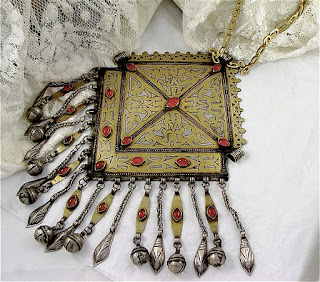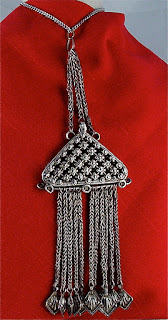See more information on this piece at http://www.artfire.com/ext/shop/product_view/craftsofthepast/3920808/Antique
This piece is known as gosa-asyk. The traditional design is an alignment of three plaques suggestive of heart shapes or female bodies. In the Teke tribe, from which this piece originates, most such pieces have areas that are gilded. In the tripartite gosa-asyk, between the three heart shapes, it is customary to place separators made of the same material. In the case above, the pieces actually were cut from the same plate of patterned and gilded silver. You can see how the pieces fit together by looking at the underside of the piece.
Both the examples that I have seen of this design of the tripartite gosa-asyk hang on a heavy leather cord which shows signs of long wear, but still very pliable and sturdy. The silver also is a plate thick enough to resist even intentional force to bend it. The plate of silver from which this Teke Turkoman family symbol is made is 2.8 mm thick.
The Turkoman that were interviewed by Dieter and Reinhold Schlechter for their book Old Silver Jewellery of the Turkoman reported that this is the Turkoman symbol for the family in their minds: Father, Mother and Child.
There are other jewelry designs that express this mindset: two larger asyk shapes with one smaller squeezed between them and all of them attached to form a solid pendant.
See more information on this piece at http://www.artfire.com/ext/shop/product_view/craftsofthepast/3780124/Turkoman
The heart or anthropomorphic female symbol expressed in the silver asyk is given by the groom's family to their daughter-in-law as a wedding present. After marriage, the woman attaches the asyk to her two braids, the married woman's traditional hair style. The Turkoman females wear more hair ornamentation than is typical among women in the Western hemisphere. In wearing this particular piece, the woman reveals her married status and shows her family's intention to increase the tribe through her fertility.
Many Turkoman pieces are shown at http://craftsofthepast.artfire.com











